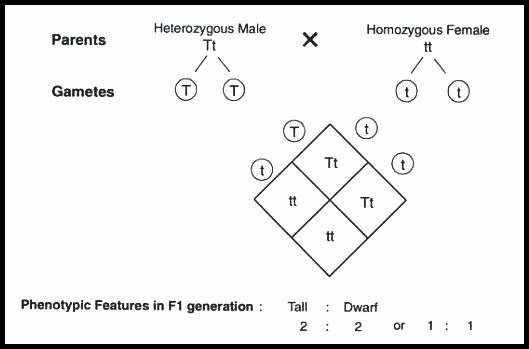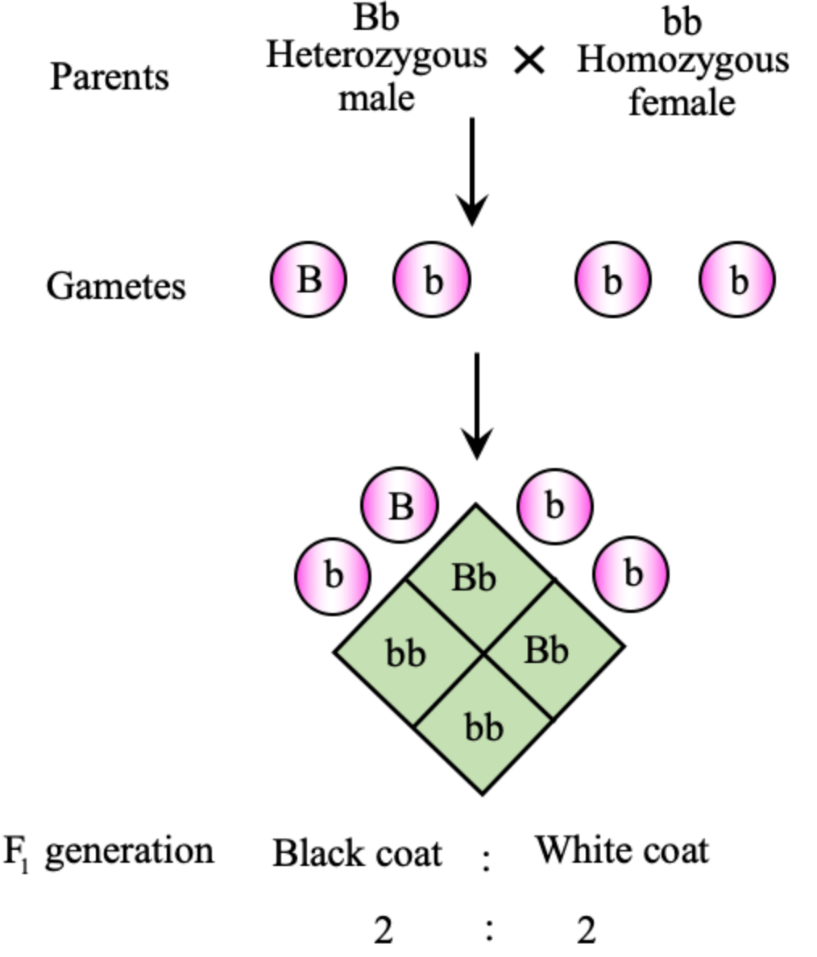
Using a punnett square workout the distribution of phenotypic features in the first filial generation after a cross between a homozygous female and heterozygous male for a single locus.


Answer
416.1k+ views
Hint: First filial or progeny is the generation of hybrids comprising a cross among the genetically different individuals known as the parents. The filial generations are arranged in a sequence of mating such that the successive generations after a parental generation are represented by the symbol
Complete answer:
Let us consider the example of Guinea pigs, a homozygous female with white colour (bb) is crossed with the heterozygous male having black colour (Bb). The male gamete will produce two kinds of gametes, i.e., B and b, at the same time as the female will produce only one kind of gamete, that’s b. The

Black colour: White colour
Genotypic ratio-
Phenotypic ratio- Black colour : white colour
In the above figure, it’s clear that it is a cross between a heterozygous male with a homozygous female. In the
Another
Hence, the ratio for phenotypic ratio is equal to the genotype ratio, that is
Note:
The filial generation is represented with the symbol F. Successive generations of progeny in a sequence of crosses, beginning with two specific individuals and selfing or intercrossing the progeny of every new
Complete answer:
Let us consider the example of Guinea pigs, a homozygous female with white colour (bb) is crossed with the heterozygous male having black colour (Bb). The male gamete will produce two kinds of gametes, i.e., B and b, at the same time as the female will produce only one kind of gamete, that’s b. The

Black colour: White colour
Genotypic ratio-
Phenotypic ratio- Black colour : white colour
In the above figure, it’s clear that it is a cross between a heterozygous male with a homozygous female. In the
Another
Hence, the ratio for phenotypic ratio is equal to the genotype ratio, that is
Note:
The filial generation is represented with the symbol F. Successive generations of progeny in a sequence of crosses, beginning with two specific individuals and selfing or intercrossing the progeny of every new
Recently Updated Pages
Master Class 12 Business Studies: Engaging Questions & Answers for Success

Master Class 12 English: Engaging Questions & Answers for Success

Master Class 12 Social Science: Engaging Questions & Answers for Success

Master Class 12 Chemistry: Engaging Questions & Answers for Success

Class 12 Question and Answer - Your Ultimate Solutions Guide

Master Class 11 Business Studies: Engaging Questions & Answers for Success

Trending doubts
Draw a labelled sketch of the human eye class 12 physics CBSE

a Tabulate the differences in the characteristics of class 12 chemistry CBSE

Which one of the following is a true fish A Jellyfish class 12 biology CBSE

Why is the cell called the structural and functional class 12 biology CBSE

Differentiate between homogeneous and heterogeneous class 12 chemistry CBSE

Write the difference between solid liquid and gas class 12 chemistry CBSE




